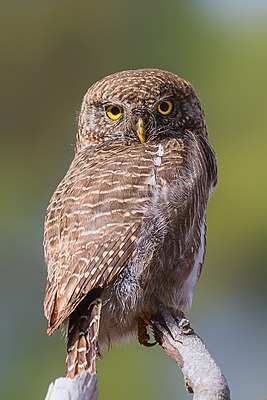Cuckoo pygmy owl
| Cuckoo pygmy owl | ||||||||||
|---|---|---|---|---|---|---|---|---|---|---|

Cuckoo pygmy owl in Uttarakhand |
||||||||||
| Systematics | ||||||||||
|
||||||||||
| Scientific name | ||||||||||
| Glaucidium cuculoides | ||||||||||
| ( Vigors , 1831) |
The cuckoo pygmy owl ( Glaucidium cuculoides , syn .: Taenioglaux cuculoides ), also called the pygmy owl , is a species of bird from the family of real owls (Strigidae).
It occurs in Southeast Asia and the Indian subcontinent , in Bangladesh , Bhutan , China , India , Indochina , Myanmar , Pakistan , Thailand and Vietnam .
The distribution area includes forest areas of temperate zones made of pine and oak , subtropical evergreen jungle , bush-lined habitats , but also parks and gardens up to 2100 m.
description
The cuckoo pygmy owl is a very small owl at 22 to 25 cm, the male weighs 150–176, the female about 240 g, the wingspan is 40 to 45 cm. The upper side is dark red-brown, the head gray-brown, the underside a little lighter feathered. The numerous light to almost white transverse changes are striking. The belly is dashed lengthways. The small, flat head with distinct “eyebrows” and a light eye ring has a distinct occipital face , the iris is bright yellow. The claws of the four toes including the tip toe are black and smooth.
The owl is similar to the jungle pygmy owl , but is larger, has yellowish-brown instead of reddish-brown transverse changes and striped flanks.
voice
The call of the male is as 7 to 14 s. long-lasting ( cuckoo-like ) trills "kwuhk-kuhk-ke-kwuhk-kwuhk-kekekwuhr-kwuhr-kwuhrr-kwurrekkwurrekwuhr" or described as a simple "Hup".
Geographic variation
The following subspecies are recognized:
- G. c. cuculoides ( Vigors , 1831), nominate form - Himalayan foothills from northeast Pakistan and Kashmir to western Sikkim
- G. c. austerum Ripley , 1948 - east Sikkim to Bhutan, northeast Assam and northwest Myanmar
- G. c. rufescens E. CS Baker , 1926 - Northeast India , Bangladesh, North Myanmar, China ( Yunnan ).
- G. c. whiteleyi ( Blyth , 1867) - southeast China (south of the Yangtze River ) and northeast Vietnam
- G. c. persimile E. JO Hartert , 1910 - Hainan
- G. c. bruegeli ( Parrot , 1908) - Southern Myanmar and Thailand
- G. c. delacouri Ripley , 1948 - North Indochina ( Laos , Vietnam)
- G. c. deignani Ripley , 1948 - Southeast Thailand and South Indochina
Way of life
The diet consists of woodpeckers , reptiles , amphibians , insects . In order to occupy a woodpecker cave, the owl kills the woodpecker. The cuckoo pygmy owl is crepuscular and diurnal , often found on an exposed hide. The wave-like flight is reminiscent of a woodpecker. The tail is often erect ( stilted ).
The breeding season is between April and June in Nepal, otherwise between April and May. The female lays 4-6 eggs and only incubates after the last egg has been laid, the chicks hatch almost simultaneously. The male takes care of the breeding female.
Hazardous situation
The cuckoo pygmy owl is not considered endangered ( least concern ).
Individual evidence
- ↑ Cuckoo Pygmy Owl , in Avibase - The World Bird Database
- ↑ Owl World
- ↑ a b c d e feather base
- ↑ a b c d e Handbook of the Birds of the World
- ↑ a b c R. Grimmett, T. Inskipp: Birds of Northern India. Helm Field Guides, 2017, ISBN 978-0-7136-5167-6
- ^ IOC World Bird List Owls
- ^ IUCN Redlist
Web links
- Videos, photos and sound recordings for Glaucidium cuculoides in the Internet Bird Collection
